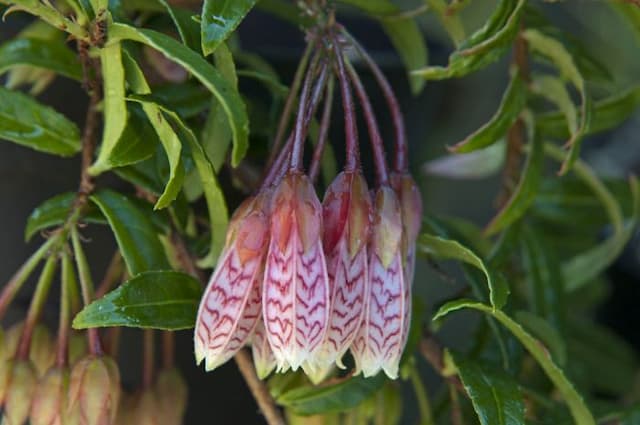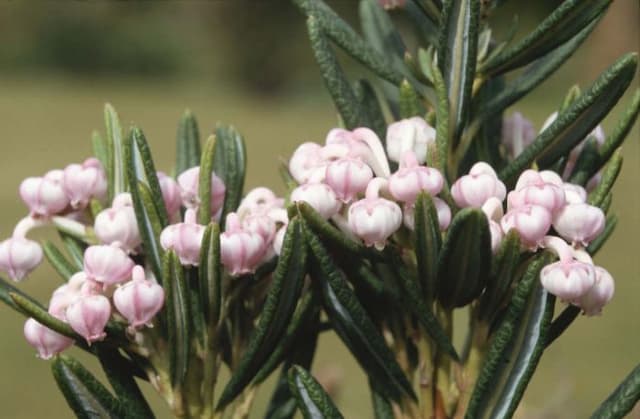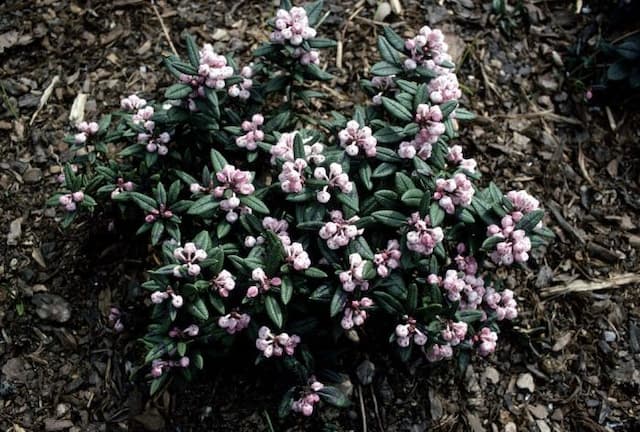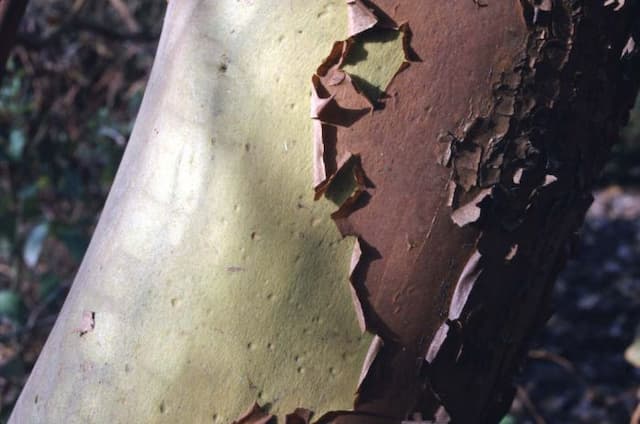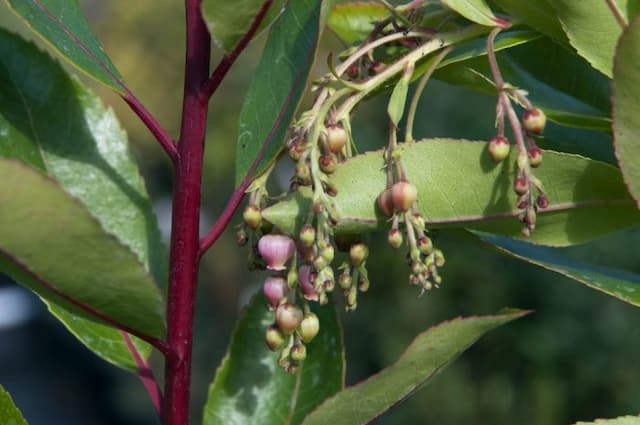Heather 'Eileen Porter' Erica carnea 'Eileen Porter'

ABOUT
'Eileen Porter' is a bushy, slow-growing, compact shrub with dark green leaves producing magenta flowers with creamy-coloured sepals in the spring
About this plant
 Names
NamesFamily
Ericaceae
Synonyms
Winter Heath, Spring Heath, Alpine Heath, Winter Flowering Heather, Snow Heath
Common names
Erica carnea 'Eileen Porter'.
 Characteristics
CharacteristicsLife cycle
Perennials
Foliage type
Evergreen
Color of leaves
Green
Flower color
Pink
Height
1 foot (0.3 meters)
Spread
2 feet (0.6 meters)
Plant type
Shrub
Hardiness zones
5
Native area
Europe
Benefits
 General Benefits
General Benefits- Aesthetic Appeal: Erica carnea 'Eileen Porter', commonly known as winter heath or spring heath, adds vibrant color to gardens during late winter and early spring when most plants are not in bloom.
- Low Maintenance: Once established, this plant is drought-tolerant and requires minimal care, making it ideal for gardeners who prefer low-maintenance landscapes.
- Attracts Pollinators: The brightly colored flowers of the winter heath attract bees and other beneficial pollinators, providing them with a food source when few other plants are flowering.
- Tolerance to Poor Soils: It can thrive in a variety of soil types, including poor soils, as long as they are well-drained.
- Cold Hardiness: Winter heath is hardy in cold climates and can survive frost and snow, making it a great choice for adding color to winter gardens in temperate regions.
- Garden Structure: The evergreen foliage of this plant provides year-round structure and texture to gardens, making it an excellent ground cover or border plant.
- Erosion Control: The dense mat-forming habit of winter heath helps to stabilize soil on slopes and prevent erosion.
- Versatility: This plant can be used in various landscaping designs, including rock gardens, alpine gardens, and as a complement to spring bulbs.
- Deer Resistance: Winter heath is generally resistant to deer, which makes it a good option for gardens in areas with a high deer population.
- Seasonal Interest: Its early bloom time adds interest to the garden at a time when other plants are typically dormant, bridging the gap between winter and spring.
 Medical Properties
Medical PropertiesThis plant is not used for medical purposes.
 Air-purifying Qualities
Air-purifying QualitiesThis plant is not specifically known for air purifying qualities.
 Other Uses
Other Uses- Eileen Porter heaths can be used as natural dyes for textiles, providing a range of colors from greens to browns depending on the mordant used.
- These plants can serve as a source of nectar for making honey when cultivated near beehives, potentially influencing the flavor profile of the honey.
- Eileen Porter heaths, when dried, can be added to potpourri mixtures for their subtle fragrance and texture.
- In landscape photography, the plant's vibrant colors can be used to create striking contrasts, particularly in winter scenes.
- The woody stems of the Eileen Porter heaths can be crafted into small decorative items or jewelry when dried and treated properly.
- These plants can be used in miniature gardens or fairy gardens due to their small size and evergreen nature, providing year-round interest.
- Sometimes used in bonsai art, they can be trained into miniature tree-like forms through careful pruning and shaping.
- They can be planted over graves as a natural grave marker that changes with the seasons and adds beauty to final resting places.
- Their consistent evergreen foliage can be used in outdoor winter arrangements and wreaths, adding color when most other plants are dormant.
- Eileen Porter heaths can be used in educational settings, such as botanical studies, to demonstrate plant adaptation and survival in alpine environments.
Interesting Facts
 Feng Shui
Feng ShuiWinter heath is not used in Feng Shui practice.
 Zodiac Sign Compitability
Zodiac Sign CompitabilityWinter heath is not used in astrology practice.
 Plant Symbolism
Plant Symbolism- Endurance and Strength: Erica carnea 'Eileen Porter', commonly known as Winter Heath, blossoms in the coldest months, symbolizing the ability to endure and thrive even in challenging conditions.
- Protection: Due to its hardy nature, Winter Heath represents a protective force against adversity.
- Solitude: With its preference for solitary growth in wild, rocky areas, this plant can symbolize a peaceful solitude.
- Longevity: Winter Heath's evergreen quality and long flowering period represent longevity and the endurance of life through time.
- New Beginnings: Blooming in late winter when few other plants do, Winter Heath is often associated with new beginnings as it heralds the approach of spring.
 Water
WaterSpring Heath, commonly known as Eileen Porter, prefers consistently moist soil without being waterlogged. During the growing season, generally from spring through fall, water the plant deeply once a week, providing about 1 gallon per square yard. Adjust the watering frequency based on weather conditions; water more often during dry spells and reduce during rainy periods. Over the winter months, reduce watering but do not allow the soil to completely dry out. Ensure good drainage to prevent root rot.
 Light
LightSpring Heath thrives in full sun to partial shade. For optimal growth, plant Eileen Porter in a location where it receives bright, indirect sunlight for the majority of the day. If planted indoors, an east or west-facing window would be ideal to provide the necessary light without the intensity of direct midday sun.
 Temperature
TemperatureThe Eileen Porter variety of Spring Heath is hardy and can withstand a range of temperatures, generally from 10°F in the winter to 75°F in the summer. It prefers cool to moderate climates and may struggle in temperatures consistently above 75°F. The ideal temperature range for robust growth would be between 45°F and 65°F.
 Pruning
PruningPruning Spring Heath, also known as Eileen Porter, helps maintain its shape and encourages bushier growth. It's best to prune right after blooming in late spring or early summer. Remove any dead or damaged branches and trim back about a third of the growth to promote new buds. Pruning too late in the season can remove next year's flower buds, so timing is essential.
 Cleaning
CleaningAs needed
 Soil
SoilWinter heath prefers well-draining, acidic soil with a pH of 4.5 to 5.5. A mix of peat moss, sand, and loamy soil often works best to maintain the necessary conditions.
 Repotting
RepottingWinter heath should be repotted every 2 to 3 years to replenish the soil and give the roots space to grow.
 Humidity & Misting
Humidity & MistingWinter heath thrives at moderate humidity levels, but it's adaptable and can tolerate the varying humidity conditions typically found in home environments.
 Suitable locations
Suitable locationsIndoor
Ensure bright light and acid soil mix for Winter heath indoors.
Outdoor
Plant in sun/part shade, acidic soil, and protect from harsh winds.
Hardiness zone
4-9 USDA
 Life cycle
Life cycleErica carnea 'Eileen Porter', commonly known as Winter Heath or Spring Heath, begins its life cycle when seeds germinate in moist, well-draining acidic soil, often in late spring or early summer. The seedlings emerge and establish a root system, followed by the development of foliage, consisting of needle-like leaves that are evergreen. As the plant matures, it enters the vegetative stage, growing wider and forming a groundcover-like mat. The flowering stage occurs typically during late winter to early spring, where the plant produces abundant small, bell-shaped flowers that can range from white to pink. After pollination, by bees or other insects, seeds are set and eventually dispersed to begin a new cycle. Winter Heath is a perennial, so it continues to grow and bloom annually for many years until it eventually reaches the end of its life span.
 Propogation
PropogationPropogation time
Late winter-early spring
The most popular method of propagating Erica carnea 'Eileen Porter', more commonly known as winter heath, is by semi-ripe cuttings. The best time to take these cuttings is in late summer to early fall. To propagate, select healthy semi-ripe shoots, around 2 to 4 inches long (approximately 5 to 10 centimeters), and remove the leaves from the lower half of the cutting. Dip the cut end into rooting hormone to encourage root development. Plant the cuttings in a mixture of half peat and half perlite or sand to ensure good drainage. Place the potted cuttings in a cold frame or under a plastic cover and keep them in a shaded location until they have rooted, which typically takes several weeks. Once rooted, they can be gradually acclimatized to outdoor conditions before planting out in their final location the following spring.
